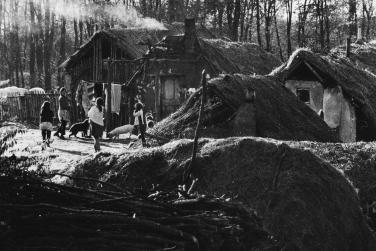
Obrazy starého sveta / Pictures of the Old World, Dusan Hanák, 1972, 64 min, Czechoslovakia
The elimination of poverty, precarity, racial discrimination and neglect in general was among the elemental promises and proclamations with which regimes in the Soviet bloc and Yugoslavia distinguished themselves.
On the contrary, the undesirables were left alone, kept out of sight or actively prosecuted. Weakness, illness, addiction, social isolation, unemployment and the complaints of minorities didn’t suit the imposed image of society and thus any research, critical consideration, documentation or representation of such impertinences were discouraged.
This program consists of three free and courageous films that were made in separate countries, glimpse at divergent matters and vary in form. Yet, there are three striking connections: all three films object this elemental deceit of the system, all three filmmakers have faith in the documentary quality of the image and they are interested in the experiences, feelings, thoughts and aspirations of the people they show, both in order to expose their abandonment and to look at personalities beyond it. The methodology of their search differs.
Želimir Žilnik’s Nezaposleni ljudi investigates a very particular moment of Yugoslavian history, the time of economic reforms and a shift towards a market-oriented order. However, the film doesn’t clarify any of these specificities but begins in the spasmic, explosive mood of the protagonists. Let down by the structure they had confidence in, workers engage in articulate, spirited and witty conversations about the menacing consequences of the transition. Žilnik keeps up with the turbulence and pace of the vigorous and sharp men he films. Sometimes he gets close to them to convey the concern and discontent in their eyes, sometimes he steps back to record the energy of their movement in appropriate framing. Žilnik doesn’t ask or catalyse any topic but his editing only retains the political essence. Eight minutes of untainted humour, impeachment and declarations.
In Mit csinálnak a cigánygyerekek?, Schiffer Pál examines the living conditions of Romani families in Eastern Hungary with a focus on schooling and segregation. Accompanied by the most important Hungarian sociologists of the period, Schiffer is as much of an interrogator on set as he is a director. His questions are that of a statistician’s: short, clear and to the point. He wants to know more and he wants his respondents to think more. He is headstrong, quick and driven by a deeply emancipatory purpose and the strong conviction that the effect of his uncomfortable questions will prompt further reflection, that both the perpetrators and the victims can conscientize prejudices and injustices. Whether listening to the inadvertent racism of the local teachers or witnessing the hopeless circumstances of the Romani children, Schiffer uncompromisingly sticks to his belief in confrontation and relentless quest for answers.
In contrast with his two colleagues, Dusan Hanák allows his film, Obrazy starého sveta to be gentle and painterly, he uses classical music and looks for beauty in nature and cinematic construction. Hanák’s film is inspired by, incorporates and extends the works of Martin Martinček, who photographed the Slovakian village Liptov and its inhabitants. As announced in the beginning of the film, they’re tied to their home. In the other two films migration appears as necessity. For the deep-rooted people of Obrazy starého sveta, immobility means a chance to be part of their world, to establish contact with the objects, the landscape and the animals, to make time for idiosyncrasies and space for creation. Their situations also mirror the negligence of the state but the director’s attention is drawn to less immediate aspects of life. It is the least enraged and warmest of all three films, it’s not motivated by the revelation of a political truth but by the representation of a modest, perhaps unsatisfactory but moving alternative to systemic fights: the care for one’s closest environment and the trust in micro-communities.
Program curated by Simon Petri-Lukács and Anna Babos, film curating students at Elias Querejeta Zine Eskola.
